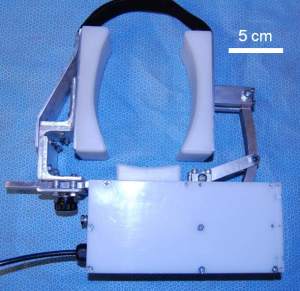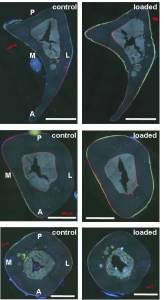Todd Dodge is a scientist who works at Hiroki Yokota’s lab which developed the beginnings of LSJL. Most of the paper is not relevant to LSJL except for his data that compares the inside of the control bone and an axial loaded bone. The difference in the cracks is not as dramatic as the control and LSJL loaded bone. This indicates that LSJL may alter bone structure more dramatically than typical loading and hopefully in such a way that facilitates neo-growth plate formation. The key takeaway is the sample LSJL device provided in the picture at the end of this article and in the appendix of Todd Dodge’s paper.
Experimental and Computational Analysis of Dynamic Loading for Bone Formation<-Link to thesis at end of article
This paper is written by Todd Dodge who works closely with Hiroki Yokota who was involved in the initial ideas behind LSJL.
“Curvature in the structure of bone was hypothesized to enhance its damping ability and lead to increased bone formation through bending. In addition, loading at frequencies near the resonant frequencies of bone was predicted to cause increased bone formation, specifically in areas that experienced high principal strains due to localized displacements during resonant vibration“<-Is there a specific frequency for cartilage formation?
“Many types of applied mechanical loading of the skeleton have been proposed as potential treatments for osteoporotic conditions, including whole body vibration, axial loading or bending of long bones, and lateral joint loading. Each mechanical loading modality is thought to strengthen bone by causing dynamic fluctuations in intramedullary fluid pressure in areas that experience enhanced stresses and strains due to the applied load. This dynamic pressure gradient{This dynamic pressure gradient may also lead to stem cells differentiating into chondrocytes to form neo-growth plates} may cause fluid flow through the lacunocanalicular network of pores in the bone, causing a shear stress to be applied to osteocytes that inhabit those pores and channels. This shear stress may excite the osteocytes, causing activation of osteoblast activity and initiation of the bone remodeling process. Mechanical loading may also lead to application of force directly to osteocytes as strain in the bone matrix changes the shape of the lacunae and canaliculae{plastic changes in the bone matrix could lead to permanent lengthening? But it is unlikely given that bone is known for not being capable of interestitial growth}, imposing deformations on the osteocyte and its processes”
Todd Dodge used lateral knee loading on OVX rats. 1N of load was used at 5Hz for 5 min for a group of rats that was tail suspended. Loading was done once a day for five straight days. For a group of rats that were OVX 15Hz for 3 min for 10 days(5 days on, then one off) 12 week-old female sprague dawley rats. So sort of medium along in the growing process with it starting to taper off.
“The slight increase in BMD in hindlimb-suspended mice may be attributed to additional mechanical stress being applied to the lumbar section of the body, possibly increasing bone growth in that area.”
Unfortunately longitudinal growth was not measured.
Here’s the tibia response to axial loading:
Compare this to the LSJL holes which are much bigger between control and loaded and are larger.
“Future studies may incorporate not only cortical bone but also trabecular bone and growth plates, as well as surrounding tissues such as muscle, skin, and joints.”<-We may need to wait for further studies to get the results we need for LSJL.
“the e ffects of loading may not only be localized to nearby bones, but may have remote impacts in the spine.”
Here’s the knee loading device that he recommends, note though it is designed for BMD not for lengthening:


